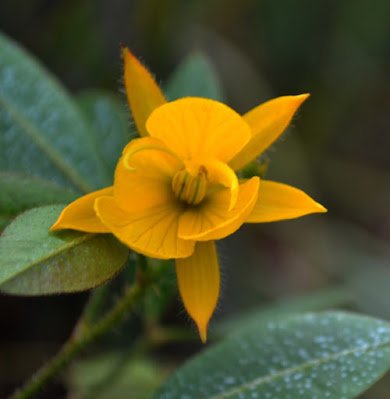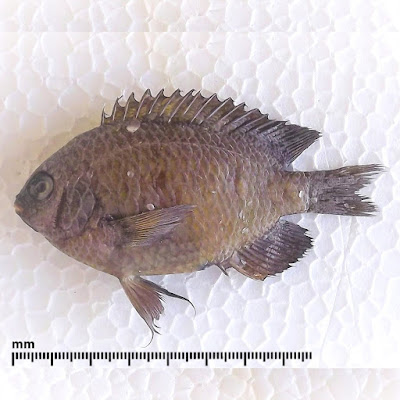[Most Recent Entries] [Calendar View]
Friday, October 30th, 2020
| Time | Event | ||
| 3:01a | [Botany • 2020] Chamaecrista (Leguminosae) of the Diamantina Plateau, Minas Gerais, Brazil, with Six New Species and Taxonomic Novelties
Abstract Floras are still important for modern biodiversity studies, as they generate basic information, as well as improve understanding on the diversity of an area. This study aimed to the taxonomic study of the species of Chamaecrista from the Diamantina Plateau in Minas Gerais, Brazil, discussing morphological characteristics of the species and presenting taxonomic novelties. The work was based on the survey of herbaria collections, literature review and field expeditions. Descriptions, an identification key, illustrations of diagnostic features, photographic plates, and commentaries are presented for the 64 species of Chamaecrista from the Diamantina Plateau. Six new species are described, two lectotypifications (C. aurivilla and C. brachystachya) and one neotypification are made (C. echinocarpa), 11 new synonyms and taxonomic changes are proposed for C. astrochiton, C. claussenii, C. echinocarpa, C. exsudans, C. multipennis, and C. orbiculata. Chamaecrista sect. Xerocalyx is treated as a species complex with four taxa although more studies are needed to better understand this group. Keywords: Campos rupestres; Espinhaço Range; inflorescences; Fabaceae; trichomes; Eudicots Matheus Martins Teixeira Cota, Juliana Gastaldello Rando and Renato Mello-Silva. 2020. Chamaecrista (Leguminosae) of the Diamantina Plateau, Minas Gerais, Brazil, with Six New Species and Taxonomic Novelties. Phytotaxa. 469(1); 1-82. DOI: 10.11646/phytotaxa.469.1.1 | ||
| 7:54a | [Entomology • 2020] Limnocoris rodriguesi • A New Species of Limnocoris Stål (Heteroptera: Naucoridae: Limnocorinae) and New State Records for Species of the Genus in Mexico
Abstract The New World genus Limnocoris Stål includes 73 described species, of which 13 are distributed in North America. A new species, Limnocoris rodriguesi Reynoso n. sp., from Mexico is described and illustrated, bringing the total number of species distributed in the country to eight. An updated checklist of the Mexican fauna of Limnocoris is presented and includes new state records for six species: Limnocoris hintoni La Rivers, L. inornatus Montandon, L. insularis Champion, L. lutzi La Rivers, L. pygmaeus La Rivers, and L. signoreti Montandon. Additionally, distribution maps for each of the species of Limnocoris in Mexico are presented. Keywords: Hemiptera, Nepomorpha, saucer bug, distribution, faunistics Limnocoris rodriguesi Reynoso NEW SPECIES Limnocoris signoreti: Rodrigues & Sites, 2019: 487 (misidentification, in part). Etymology. The specific epithet is a patronym in honor of Higor D. D. Rodrigues (Instituto Oswaldo Cruz), a dear friend, colleague, and the specialist in the saucer bug genus Limnocoris. Daniel Reynoso-Velasco. 2020. A New Species of Limnocoris Stål (Heteroptera: Naucoridae: Limnocorinae) and New State Records for Species of the Genus in Mexico. Zootaxa. 4860(3); 375–392. DOI: 10.11646/zootaxa.4860.3.3 | ||
| 8:04a | [Ichthyology • 2020] Pomacentrus bangladeshius • A New Species of Damselfish (Perciformes, Pomacentridae) from Saint Martin’s Island, Bangladesh
Abstract A new species of damselfish, Pomacentrus bangladeshius, is described from 3 specimens, 67–77 mm standard length (SL), collected from Saint Martin’s Island, Bangladesh. The new species is distinguished from congeners in having the following combination of characters: XIV, 13 dorsal-fin elements; II, 14 anal-fin elements; 19 pectoral-fin rays; 18–19 lateral-line scales; 17–19 gill rakers on first arch; body depth 1.68–1.88 (1.88) in SL; snout 4.17–4.60 (4.17) in head length; head 2.91–3.09 (3.08) in SL; a prominent notch present between preorbital and suborbital; olive to dark brown body color, dark brown premaxilla, and yellow iris with a narrow bronze eye ring. The new species inhabits shallow reef flats around rock and coral outcrops. Phylogenetic analysis also shows the clear divergence of P. bangladeshius from other genetically closely related congeneric species retrieved from GenBank and that it represents a separate lineage. Keywords: Pisces, Bengal demoiselle, morphology, DNA barcoding Kazi Ahsan Habib, Md Jayedul Islam, Najmun Nahar and Amit Kumer Neogi. 2020. Pomacentrus bangladeshius, A New Species of Damselfish (Perciformes, Pomacentridae) from Saint Martin’s Island, Bangladesh. Zootaxa. 4860(3); 413–424. DOI: 10.11646/zootaxa.4860.3.6 | ||
| 8:23a | [Arachnida • 2020] A Systematic Revision of Draculoides (Schizomida: Hubbardiidae) of the Pilbara, Western Australia, Part I: the Western Pilbara
Abstract The schizomid fauna of mainland Australia currently comprises 60 species within seven named genera, of which five are endemic to the continent: Attenuizomus Harvey, 2000, Brignolizomus Harvey, 2000, Draculoides Harvey, 1992, Julattenius Harvey, 1992, Notozomus Harvey, 2000. Most Australian schizomids have been described from eastern and northern Australia, but there is also a significant subterranean fauna that has been found in hypogean habitats in the semi-arid Pilbara region of Western Australia. The vast majority of these species can be assigned to the genus Draculoides and this study is the first in a proposed series to revise this highly diverse genus. We treat the species found in the western Pilbara region, which includes 13 new species and 13 previously named species, using morphological characters and multi-locus sequence data. We also incorporate a molecular “mini-barcode” approach for COI, 12S and ITS2 to diagnose the new species. The new species are named: Draculoides akashae Abrams and Harvey, n. sp., D. belalugosii Abrams and Harvey, n. sp., D. carmillae Abrams and Harvey, n. sp., D. christopherleei Abrams and Harvey, n. sp., D. claudiae Abrams and Harvey, n. sp., D. immortalis Abrams and Harvey, n. sp., D. karenbassettae Abrams and Harvey, n. sp., D. mckechnieorum Abrams and Harvey, n. sp., D. minae Abrams and Harvey, n. sp., D. noctigrassator Abrams and Harvey, n. sp., D. nosferatu Abrams and Harvey, n. sp., D. piscivultus Abrams and Harvey, n. sp. and D. warramboo Abrams and Harvey, n. sp. We also provide the first descriptions of males of D. anachoretus (Harvey, Berry, Edward and Humphreys, 2008) and D. gnophicola (Harvey, Berry, Edward and Humphreys, 2008). All of the new species are subterranean-dwelling, short-range endemic species that occur in regions subject to mining activities, rendering them of high conservation significance. Keywords: Arachnida, subterranean, taxonomy, systematics, molecular taxonomy, new species Kym M. Abrams, Joel A. Huey, Mia J. Hillyer, Raphael K. Didham and Mark S. Harvey. 2020. A Systematic Revision of Draculoides (Schizomida: Hubbardiidae) of the Pilbara, Western Australia, Part I: the Western Pilbara. Zootaxa. 4864(1); 1-75. DOI: 10.11646/zootaxa.4864.1.1 Researchers count 13 new species of fanged arachnids in the Pilbara Abstract: We used molecular and morphological techniques to study troglobitic schizomids inhabiting a variety of subterranean landforms in semiarid Western Australia. The study was designed to explore the taxonomic and phylogenetic status of newly discovered populations of subterranean schizomids. Molecular sequences of the mitochondrial DNA (mtDNA) cytochrome oxidase subunit 1 (COI) and small subunit rRNA (12S) were obtained from a total of 73 schizomid specimens. Populations sampled from boreholes within mesa landforms in the Robe Valley were highly genetically distinct from species of Draculoides Harvey, 1992 found elsewhere in the Pilbara (Cape Range and Barrow Island). Pronounced genetic structuring was also evident at a fine spatial scale within the Robe Valley, with populations from each of the mesas examined exhibiting unique and highly divergent mtDNA lineages. These molecular data were generally supported by small but significant morphological features, usually in the secondary male structures, but some species were represented only by female specimens that possessed more conservative morphologies. The molecular data defined two major in-group clades, which were supported by morphological differences. One clade was widespread and included the type species of Draculoides, D. vinei (Harvey), along with D. bramstokeri Harvey & Humphreys, D. brooksi Harvey, D. julianneae Harvey, D. mesozeirus, sp. nov. and D. neoanthropus, sp. nov. The second clade was restricted to the Robe Valley and deemed to represent a new genus, Paradraculoides, which included four new species P. anachoretus, sp. nov., P. bythius, sp. nov., P. gnophicola, sp. nov. and P. kryptus, sp. nov. (type species). Mark S. Harvey A D , Oliver Berry B , Karen L. Edward A and Garth Humphreys C. 2008. Molecular and morphological systematics of hypogean schizomids (Schizomida : Hubbardiidae) in semiarid Australia. Invertebrate Systematics. 22(2); 167-194. DOI: 10.1071/IS07026 |
| << Previous Day |
2020/10/30 [Calendar] |
Next Day >> |







